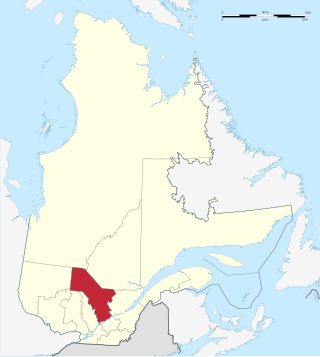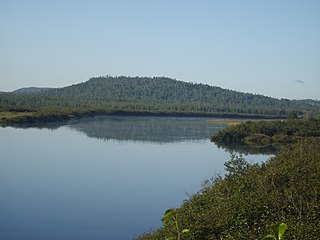
The Cree are a North American Indigenous people. They live primarily in Canada, where they form one of the country's largest First Nations.

La Tuque is a city located in north-central Quebec, Canada, on the Saint-Maurice River, between Trois-Rivières and Chambord. The population was 11,129 at the 2021 Canadian census, most of which live within the urban area. At over 28,000 km2 (11,000 sq mi), it is the largest city in Canada by area.

The Saint-Maurice River flows north to south in central Quebec from Gouin Reservoir to empty into the Saint Lawrence River at Trois-Rivières, in the province of Quebec, in Canada. From its source at Gouin Reservoir, located at the same latitude as the Lac Saint-Jean, the river has a total drop of about 405 metres (1,329 ft), to finally reach the St. Lawrence river at Trois-Rivières. The river is 563 km long and has a drainage basin of 43,300 square kilometres (16,700 sq mi). Saint-Maurice River is one of the most important tributaries of the St. Lawrence River.

Mauricie is a traditional and current administrative region of Quebec. La Mauricie National Park is contained within the region, making tourism in Mauricie popular. The region has a land area of 35,860.05 km² and a population of 266,112 residents as of the 2016 Census. Its largest cities are Trois-Rivières and Shawinigan.
Lake Manouane is a lake in central Quebec, Canada. It is just north-east of Kempt Lake, mostly within the boundaries of the City of La Tuque. It should not be confused with more northerly Lake Manouane in the Peribonka River watershed.
La Romaine, also known as Unamenshipit in Innu-aimun, is an Innu First Nations reserve in the Côte-Nord region of Quebec, Canada, at the mouth of the Olomane River on the Gulf of Saint Lawrence. It belongs to the Innu band of Unamen Shipu. Being an enclave within the Municipality of Côte-Nord-du-Golfe-du-Saint-Laurent, it is geographically within Le Golfe-du-Saint-Laurent Regional County Municipality but administratively not part of it. Directly adjacent to the reserve is the community of La Romaine consisting of a small French-speaking population.

Pessamit, is a First Nations reserve and Innu community in the Canadian province of Quebec, located about 50 kilometres (31 mi) southwest from Baie-Comeau along the north shore of the Saint Lawrence River at the mouth of the Betsiamites River. It is across the river directly north of Rimouski, Quebec. It belongs to the Pessamit Innu Band.

Grandes-Piles is a village municipality in the Mauricie region of the province of Quebec in Canada.

Mashteuiatsh is a First Nations reserve in the Saguenay–Lac-Saint-Jean region of Quebec, Canada, about 6 kilometres (3.7 mi) north from the centre of Roberval. It is the home to the Pekuakamiulnuatsh First Nation. It is located on a headland jutting out on the western shores of Lake Saint-Jean known as Pointe-Bleue, in the geographic township of Ouiatchouan, and belongs to the Montagnais du Lac St-Jean Innu band. It is geographically within the Le Domaine-du-Roy Regional County Municipality but administratively not part of it.

Obedjiwan is a First Nations reserve and village on the north shore of Gouin Reservoir in the Mauricie region of Quebec, Canada. It belongs to the Atikamekw of Opitciwan band of the Atikamekw Nation.
Coucoucache was a tiny First Nation reserve, in Cloutier Township, on the north shore of Reservoir Blanc on the Saint-Maurice River in the Mauricie region of Quebec, Canada. It belonged to the Atikamekw First Nation of Wemotaci but had no permanent population in recent decades.

Manawan, officially named communauté Atikamekw de Manawan, is a First Nations reserve on the south-western shores of Lake Métabeskéga in the Lanaudière region of Quebec, Canada. It belongs to the Atikamekw of Manawan band of the Atikamekw Nation.

The Manouane River flows from west to east in the Haute-Mauricie (Upper-Mauricie), at northwest of La Tuque, in the administrative region of Lanaudière and Mauricie, in the Province of Quebec, Canada. The river basin is mostly covered by forest.
Sanmaur is a village in the Haute-Mauricie, in La Tuque, in Québec, Canada. Sanmaur was incorporated into the city of La Tuque in 2003.

The Vermillon River flows in the territory of La Tuque, in Upper-Mauricie, in the administrative region of Mauricie, in Quebec, Canada.

The Lake Châteauvert is located on the path of the Manouane River, at the west of Saint-Maurice River in the territory of La Tuque, in Mauricie, in Quebec, in Canada.

The Rivière Blanche flows eastwards, draining the region between Casey and Wemotaci, in La Tuque, in Mauricie, Quebec, in Canada. The “Rivière Blanche” is the main tributary of the Manouane River, and is part of the watershed of Saint-Maurice River.

The Jean-Pierre River is a tributary of the Jean-Pierre Bay, on the south shore of the Gouin Reservoir, flowing into the territory of the town of La Tuque, into the administrative region of Mauricie, in Quebec, in Canada.

The Kikendatch Bay is a freshwater body that leads to the Gouin Reservoir, in the territory of La Tuque, in Haute-Mauricie, in the administrative region of Mauricie, in the province of Quebec, in Canada.
The La Loutre dam is a river infrastructure downstream from the Gouin Dam. This dam is the second on the Saint-Maurice River from the source. It is located in the city of La Tuque, in Mauricie, in the province of Quebec, in Canada.














